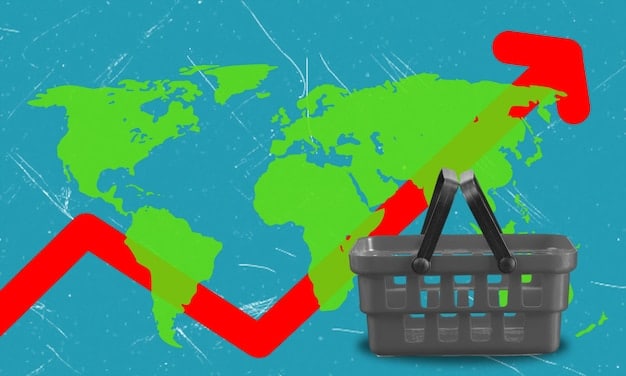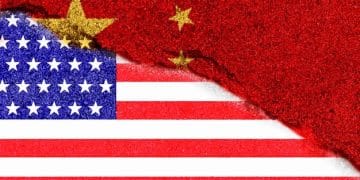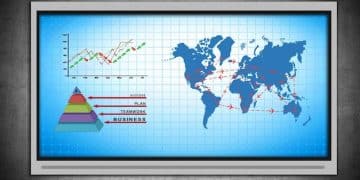US Trade Policy: Impact of 7% Tariff Increase on Imported Goods

A US trade policy update reveals a 7% tariff increase on imported goods, which could significantly impact consumers by raising prices and potentially altering purchasing behaviors.
The recent US trade policy update: What the 7% tariff increase on imported goods means for consumers is poised to reshape the economic landscape for American households. This policy shift could affect everything from grocery bills to major purchases, raising critical questions about how consumers will navigate these changes.
Understanding the New US Trade Policy
The introduction of new trade policies often brings about a mix of anticipation and concern, primarily centered on how these changes will affect the everyday consumer. The recent announcement of a 7% tariff increase on imported goods is no exception, necessitating a closer examination of its potential implications.
What is a Tariff and How Does it Work?
Tariffs are essentially taxes imposed on imported goods. They are levied by the importing country’s government and are usually a percentage of the value of the goods or a fixed amount per unit. The purpose of tariffs can be varied, from protecting domestic industries to raising revenue for the government.
The Mechanics of Tariff Implementation
When a tariff is implemented, it increases the cost of imported goods. This cost is often passed on to consumers in the form of higher prices. The increase in price can make imported goods less competitive compared to domestically produced goods, potentially boosting local industries. However, it also means that consumers may have to pay more for the same products.

Here are several key points to consider regarding tariffs:
- Tariffs can lead to retaliatory tariffs from other countries, sparking trade wars.
- They can protect domestic industries but may also make them less competitive in the long run.
- Consumers often bear the brunt of tariffs through higher prices.
In summary, tariffs are a complex tool with both potential benefits and drawbacks, and their implementation requires careful consideration of the broader economic impact.
Reasons Behind the 7% Tariff Increase
Understanding the rationale behind the 7% tariff increase is crucial for both businesses and consumers. Trade policies are not formulated in a vacuum; they’re often responses to broader economic trends, geopolitical strategies, or specific domestic pressures. This increase is driven by several factors.
Protecting Domestic Industries: A Primary Driver
One of the main reasons governments impose tariffs is to protect domestic industries from foreign competition. By making imported goods more expensive, domestic producers gain a competitive edge. This protection can be particularly important for industries that are still developing or struggling to compete with established international players.
Geopolitical Considerations and Trade Negotiations
Tariffs are also frequently used as leverage in trade negotiations. A country might impose tariffs on specific goods from another country to encourage them to change their trade practices. These types of tariffs are often part of larger diplomatic strategies aimed at achieving specific economic or political goals.
Key reasons for the 7% tariff increase on imported goods:
- To provide a competitive advantage to US-based companies.
- To encourage other nations to negotiate trade agreements more favorably.
- To address trade imbalances and reduce the trade deficit.
To sum it up, the 7% tariff increase is a strategic measure intended to balance protecting domestic industries with broader geopolitical and economic goals.
Impact on Consumer Goods and Prices
The imposition of a 7% tariff increase on imported goods is likely to have a direct and significant impact on the prices of consumer goods. This change may affect a wide range of products, from everyday household items to more specialized and luxury goods.
Immediate Price Increases on Imported Products
The most immediate and noticeable effect of the tariff increase is the rise in prices of imported products. Retailers who import goods will likely pass on the additional cost to consumers. This means that shoppers can expect to see higher prices on a variety of items, depending on their origin.
Potential Shift in Consumer Purchasing Behavior
As prices rise, consumers may begin to change their purchasing behavior. Some may opt for cheaper, domestically produced alternatives, while others may reduce their overall consumption. This shift could have broader implications for both domestic and international markets.

Here’s how the tariff changes can affect consumer behavior:
- Consumers may switch to domestically produced goods.
- They might delay or reduce purchases of non-essential items.
- Some consumers may absorb the price increase for essential goods.
All in all, the tariff increase on imported goods is set to change the dynamics of consumer spending, prompting adjustments in purchasing habits across the board.
Industries Most Affected by the Tariff Hike
While the tariff increase on imported goods will have widespread effects, some industries are likely to feel the impact more acutely than others. These sectors often rely heavily on imported materials or sell a large portion of their products overseas, making them particularly vulnerable to changes in trade policy.
The Automotive Industry: A Major Player
The automotive industry, which depends on a complex web of international supply chains, is one of the most exposed. Car manufacturers often import parts and components from various countries, and a tariff increase could significantly raise production costs, ultimately affecting the price of vehicles.
The Electronics Sector: High Import Dependency
The electronics sector is also highly dependent on imports, particularly for components like semiconductors and displays. Increased costs due to tariffs could make electronic devices like smartphones, laptops, and televisions more expensive for consumers.
Other sectors affected include:
- Apparel industry: Relies heavily on textiles and garments from overseas.
- Food and beverage industry: Imports many ingredients and finished products.
- Retail sector: Sells a wide range of imported consumer goods.
In conclusion, the tariff increase poses significant challenges for industries that rely on global supply chains, potentially leading to higher prices and shifts in market dynamics.
Strategies for Consumers to Cope with Higher Prices
With the increase, consumers will need to adopt new strategies to manage their budgets and purchasing decisions. Fortunately, there are several steps individuals can take to mitigate the impact of higher prices on imported goods.
Embrace Value Shopping and Discount Retailers
One of the most effective ways to save money is to shop at value retailers and discount stores. These establishments often sell products at lower prices by cutting costs in other areas, such as marketing or store décor. Consumers can find many of the same items they need at a fraction of the price.
Compare Prices and Look for Deals
Price comparison is another valuable tool. With numerous online platforms and apps that allow consumers to compare prices across different retailers, it’s easier than ever to find the best deals. Additionally, signing up for email newsletters and following retailers on social media can provide access to exclusive deals and promotions.
Strategies for consumers to manage the rising prices:
- Opt for generic or store-brand products over name brands.
- Buy in bulk when possible to take advantage of volume discounts.
- Reduce consumption of non-essential goods to save money.
Ultimately, by making informed purchasing decisions and adopting smart shopping habits, consumers can effectively navigate the challenges posed by the increase on imported goods.
Long-Term Implications of the Trade Policy
The implications of the increase extend beyond immediate price changes and encompass a range of long-term effects on the economy, trade relationships, and consumer behavior. It’s essential to consider these broader consequences to understand the full scope of the policy shift.
Potential for Trade Wars and Retaliatory Tariffs
One of the significant long-term risks is the possibility of trade wars. When one country imposes tariffs, others may retaliate with their own tariffs, leading to a cycle of escalating trade barriers. This can disrupt international trade flows and negatively impact economic growth worldwide.
Impact on International Trade Relations
The increase can strain relationships between the US and its trading partners. Countries may view tariffs as protectionist measures that violate international trade agreements. This can lead to disputes and a breakdown in cooperation on other global issues.
Here is how the trade policy may influence the long term:
- Promoting domestic production and reducing reliance on imports.
- Inspiring innovation and competitiveness among domestic companies.
- Creating new jobs in industries that benefit from protectionist measures.
In summary, while the policy shift may offer short-term benefits to specific industries, the long-term implications could include strained trade relations, reduced global growth, and increased costs for consumers.
| Key Point | Brief Description |
|---|---|
| 💰 Price Increase | Consumers will likely see higher prices on imported goods. |
| 🛒 Purchasing Shifts | Consumers may switch to domestic products or reduce spending. |
| 🏭 Industry Impacts | Sectors like automotive and electronics face rising costs. |
| 🤝 Trade Relations | Potential for strained relations and retaliatory tariffs. |
Frequently Asked Questions
▼
A tariff is a tax or duty imposed on imported goods and services. It’s a common tool used by governments to protect domestic industries or to influence trade policies with other countries.
▼
The increase is intended to protect US industries, improve trade imbalances, and encourage other countries to negotiate more favorable trade agreements with the United States.
▼
Consumers can anticipate higher prices on many imported goods. This may lead to changes in purchasing habits, such as opting for domestic products or cutting back on non-essential spending.
▼
Industries that heavily rely on imported components or sell many products overseas will be most affected. This includes automotive, electronics, apparel, and the food and beverage sectors.
▼
Consumers can shop at discount retailers, compare prices to locate deals, consider store-brand products, buy in bulk when possible, and cut back on non-essential purchases to save money.
Conclusion
In conclusion, the **US trade policy update: What the 7% tariff increase on imported goods means for consumers** presents both challenges and opportunities. While consumers may face higher prices, adapting with smart shopping strategies and supporting domestic industries can help mitigate the impact.





